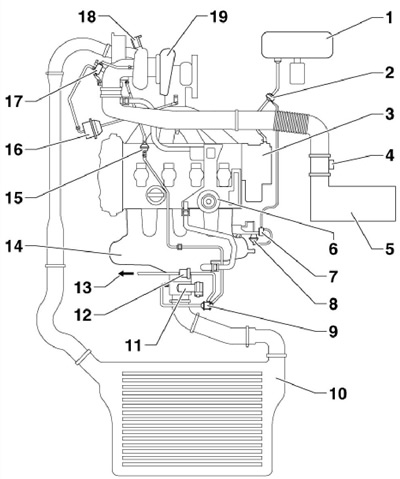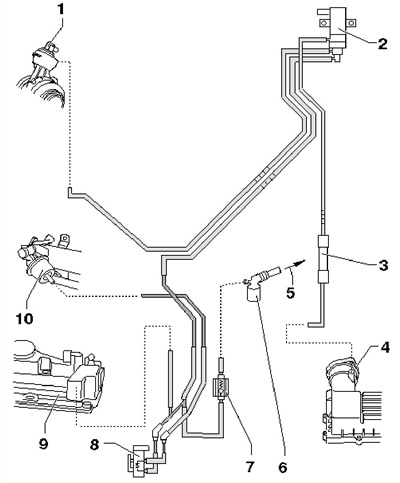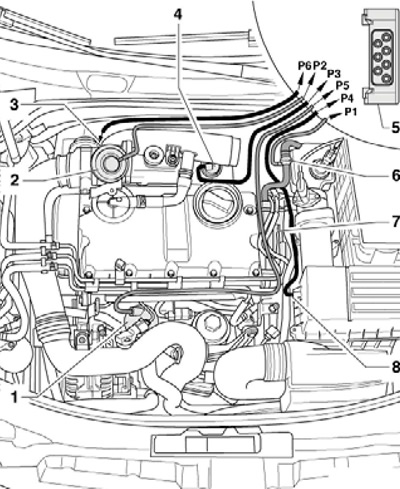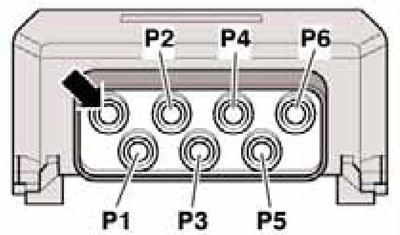Petrol models
Air supply system includes air intake, air cleaner, turbocharger (except for 3.6 l engine), intercooler (except for the 3.6 l engine; on the 1.4L engine, an additional intercooler radiator is used), throttle valve and intake manifold.
An electronically controlled throttle valve from the gas pedal position sensor and the ECM is used to control the air supply. The throttle valve is actuated by an e / motor based on a signal from the gas pedal position sensor. The throttle position is controlled by the TPS sensor.
All petrol engines except 3.6L are turbocharged with charge air cooling (intercooler). The turbocharging scheme for 1.8 and 2.0 l engines is shown in illustration 1.4. The turbocharger consists of two elements (turbine and compressor), mounted on one shaft and enclosed in a common housing. The turbocharger bearings receive oil for cooling and lubrication from the engine via an oil supply line. The oil returns to the crankcase through the oil return line. The turbocharger and exhaust manifold are combined into one non-separable unit and are not supplied separately.

1.4 Scheme of turbocharging of engines 1.8 and 2.0 l
1 Vacuum brake booster
2 Non-return valve with connection
3 Vacuum pump
4 MAF sensor "G70"
5 Air cleaner
6 Crankcase ventilation, with pressure regulating valve
7 Valve "N145" changes in intake manifold geometry
8 Setting piece for intake manifold damper valve
9 Double non-return valve, with solenoid valve 12
10 Intercooler
11 Throttle valve module "J338"
12 Solenoid valve No. 1 "N80" canister purge EVAP, with valve 9
13 To EVAP canister
14 Inlet pipeline
15 Non-return valve
16 Boost pressure control module
17 Solenoid valve "N75" boost pressure adjustment
18 Valve "N249" exhaust air turbocharger
19 Turbocharger
The turbocharger increases the pressure of the purified atmospheric air, thereby increasing the amount of air entering the cylinder per cycle. With more oxygen, more fuel can burn. Thus, with the same characteristics of the displacement and speed, better power figures are achieved. The air heated in the turbocharger passes through the intercooler where it is cooled. When cooled, the air density increases and, because. more oxygen enters the combustion chambers, an additional increase in power occurs. The boost pressure regulator controls the amount of air supplied by the turbocharger. Solenoid valve "N75" boost pressure limitation is an electro-pneumatic device. With this valve, the vacuum is regulated, through which the guide vane control mechanism operates. When a valve fails "N75" the vacuum necessary for the operation of the vacuum drive is not created and the vacuum drive spring sets the control rod to a position where the turbine guide vanes are oriented at a large angle (emergency mode). In this case, at low engine speeds and therefore at low exhaust gas pressures, only low boost pressures are possible; engine power is insufficient and active regeneration of the particulate filter is not possible.
Diesel models
The air sucked in from the atmosphere passes through the air cleaner. The air cleaner element must be replaced periodically (see Section 16 Chapter 1).
All diesel engines use turbocharging, with charge air cooling (intercooler). The principle of operation of the turbocharger is described in subsection "Gasoline engines" higher.
A vacuum is used to control the operation of the turbocharger. The scheme of control vacuum lines is shown in illustration 1.5a-c.

1.5a Scheme of control vacuum lines for diesel models 2.0 TDI-CR (CFFB, CFGB, CLJA)
1 Vacuum block on turbocharger, with position sensor "G581"
2 Solenoid valve "N75" boost pressure control
3 Silencer
4 Air cleaner
5 To brake booster
6 Connecting piece on the vacuum pump
7 Non-return valve
8 EGR radiator with diverter valve "N345"
9 Cylinder head cover with integrated vacuum reservoir
10 Vacuum unit for switching the EGR radiator

1.5b Laying the vacuum lines of the diesel engine 1.9 TDI-PD (WHE)
1 Vacuum reservoir
2 Mechanical EGR valve
3 To vacuum boost pressure regulator
4 EGR damper vacuum regulator
5 Valve block, with changeover "N345" and return "N18" EGR radiator valves, as well as with an e / m valve "N75" boost pressure adjustment
6 Vacuum line, from tandem pump to block 5
7 Tandem pump
8 Ventilation hose, to air cleaner

1.5s Wiring Diagram for 1.9 TDI-PD Diesel Vacuum Valve Block (WHE)
P1 Vacuum line, from double pump
P2 To mechanical EGR valve
РЗ To the EGR damper vacuum regulator
P4 Ventilation hose to air cleaner
P5 To vacuum reservoir
P6 To the vacuum boost pressure regulator
The air supply path also includes EGR and PCV systems (see Part B).
In the direction of flow, in front of the intake manifold, in front of the EGR valve inlet, a throttle valve block is installed "J338". It contains an e / motor, which smoothly controls the position of the damper through a gearbox depending on the load and engine speed. A throttle position sensor is built into the throttle actuator, designed to implement feedback from the engine control system. The throttle body has the following purpose.
- In some modes, the throttle valve is used to create a pressure differential between the intake tract and the EGR circuit. This pressure differential contributes to more efficient operation of the EGR system.
- In particulate filter regeneration mode, the throttle valve controls the inlet air flow.
- When the engine is turned off, the damper closes, gradually reducing the amount of incoming air to smoothly stop the engine.
If the throttle valve unit fails, correct control of the exhaust gas recirculation process and active regeneration of the particulate filter become impossible.
Ensuring safety and cleanliness when working on the fuel supply system
Caution: Fuel injection equipment is manufactured to very precise tolerances and with very close clearances, so it is especially important to maintain absolute cleanliness when working with these components. Be sure to insert plugs into any open holes or lines.
Attention: When loosening and tightening the union nuts securing the pressure fuel lines, simultaneously press the flared end of the fuel line against the injector and remove (suck) fouling with vacuum to prevent dirt from entering the power system. Do not allow the flare nuts to hit the flared edges of the new fuel pipes, as this may damage them and introduce foreign particles into the tubes. Close the holes formed after disconnecting the tubes with clean plugs.
- Do not work on the fuel system near an open flame, do not smoke and do not turn on heaters! Keep a fire extinguisher ready.
- Always disconnect the negative cable from the battery before working on the fuel system to prevent sparks. Before disconnecting the battery, read the trouble codes (see chapter 5).
- Keep the workplace well ventilated - fuel vapors are poisonous.
- Before working on the fuel supply system of gasoline models, fuses SD14 and SD30 must be removed so that the fuel pump does not turn on when the driver's door is opened.
- Do not allow gasoline to come into contact with rubber or leather surfaces, as in doing so, they may be damaged.
- The fuel system is pressurized and fuel may escape when it is opened - wear protective goggles. Clean up spilled fuel with a rag.
- Hose connections are fastened with tape or clamp clamps. The clamping clamps should be replaced with band clamps during disassembly.
- Clean connections and their surroundings thoroughly before opening.
- Place the removed components on a clean pad and cover with polyethylene, paper or lint-free rags.
- Close open male connectors, for example with suitable clean plugs.
- Install only clean parts - remove replacement components from the packaging immediately before installation. Do not use parts that have been stored without packaging.
- Avoid using compressed air with an open fuel system, if possible try not to move the vehicle.
- Do not use sealants containing silicone, as silicone particles that get into the engine do not burn out and can cause failure of the lambda probes.
- Before removing the fuel tank, pump out the fuel from it with a pump specially designed for this purpose.
- Remember that even an empty fuel tank remains explosive.
- After installing the fuel system components, start the engine and check all connections for leaks.
